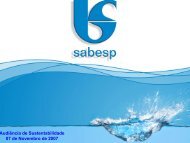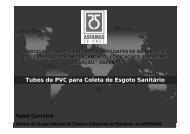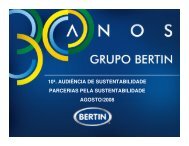Sustainability r e p o r t - Sabesp
Sustainability r e p o r t - Sabesp
Sustainability r e p o r t - Sabesp
You also want an ePaper? Increase the reach of your titles
YUMPU automatically turns print PDFs into web optimized ePapers that Google loves.
ReportbenchmarksPeriod and limitsThe data included in this report reflect particularly the achievements of <strong>Sabesp</strong> in 2009 and goals for different periods.It contains descriptions of goals for 2010 in the economic and financial, social, and environmental dimensions.It reports on operational indicators, the water treatment rate, new water connections, water losses, the sewagecollection rate—involving our structuring programs. These indicators are presented for the period 2010-2018, when,as we state in our vision, we intend to be “recognized as the company that has managed to provide universal waterand sewage services in our area of operation...”. Historical series for the 2004-2009 period are presented in theIndicators Panel and in the rest of the report. The historical evolution of the indicators of population served, waterand sewage service rates, is presented for the period 1994-2009.Report preparation processGRI 3.13 This is our third sustainability built up based on the guidelines of the Global Reporting Initiative (GRI).For the economic and financial statements available on the internet, we followed the standards issued by theBrazilian Securities and Exchange Commission (CVM), the Brazilian Association of Listed Companies (Abrasca), andthe transparent communication principles of the Brazilian Association of Corporate Communication (Aberje). For thecorporate responsibility and sustainability aspects we used the Global Reporting Initiative (GRI) model, and for theSocial Balance Sheet the Social Balance Preparation Guide of the Brazilian Institute of Social and Economic Analyses(Ibase) and the prepared by Instituto Ethos. Since 2006, we are signatories of the Global Pact, a United NationsOrganization (UNO) initiative that gathers companies, workers, and civil society to promote sustainable growth andcitizenship.In the two previous year we declared level C of GRI. This year, we declare level B because of the enhancements madeand the consequent higher number of benchmarks met. We have the intention of enhancing our sustainability report,by seeking, whenever possible, the verification of external appraisers.MethodologyWe opted not to include in the survey stakeholders mainly involved in the economic and financial dimension. Onthe other hand, this is a very technical audience, who has special opportunities to know our results throughoutthe year, though road-shows and conference calls. Note also that this dimension is subject matter of specialguidelines issued by regulator/standard makers, such as CVM, CFC and CPC, and legislation and accountingstandards that set reporting regulations. The methodology adopted to capture the positions of stakeholdersinvolved sending a web-based questionnaire to more than 600 email addresses of NGOs and associationsregistered by us, to be replied only by one lead. We received 54 replies. A scoring range from 0 to 10 wasdefined for each topic. The topics were chosen from those considered applicable to the water and waste industryand our business environment. In addition to asking the NGO to give score what they consider important forsociety—scores used in the matrices—we asked them to score what they consider material for their activities.Additionally, in order to measure the level of importance actually given to a given topic, in the face of the report,we counted the number of words in the texts that focus more on each topic. The option for the web-basedquestionnaire was based on our expecting obtaining benefits from a larger sample of stakeholders, as these couldanalyze on our website, the draft, almost final, report, and the increase freedom to state one’s position, usingindividualized replies. This, theoretically, would compensate the lack of deeper view based on the discussions insegment groups. In effect, there were not conducted in the commitment panels organized at the end of 2009,which only had plenary sessions. We intend to resolve these methodological issues in future issues of the report.Note: The 2009 customer satisfaction survey included, for the first time, questions to check which they think arethe priority areas where we should socio-environmental activities and actions (see end of section “Environment”).We note, in a free comparison, that the rational use of water, waste recycling, and environmental educationalso received high scores. We made an alternative checking of the level of result consistency, and obtained thefollowing straight-line correlation ratios:Table 32: <strong>Sabesp</strong> to NGOs positions straight-line correlation ratios<strong>Sabesp</strong> position to NGOsposition correlation<strong>Sabesp</strong> position to # of wordscorrelationEnvironmental 0.87 0.68Social 0.60 0.78Materiality MatrixIn order to establish a relationship between what we construe as material, to be highlighted in the report, andthe environmental and social dimensions, and what society points out as being important, we used for the firsttime the materiality matrix tool, presented below, separately for each dimension. The materiality matrix is agraphic way to relate a company’s vision with the society’s expectations The ideal situation is when a cloud ofdots representing each topic concentrate in the top right corner, indicating high consistency between both visions.As we can see in the matrices generated, this occurred, with a slight advantage to the social dimension.We should comment the relatively low correlation between what we consider as topics in principle more materialfor the report and the length of the related texts. Even though length is not a definite criterion to measure themateriality of a topic, the issue should be reviewed during the planning stage of future issues.152 Relatório de Sustentabilidade 2009 153



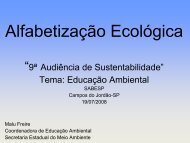
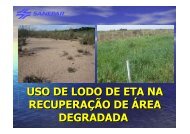
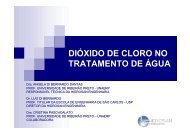
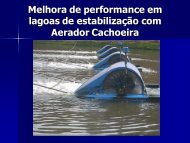
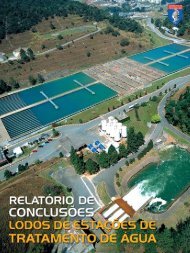
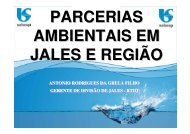
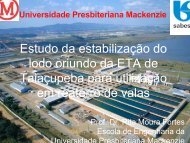
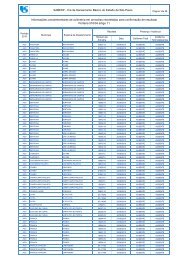
![MBBR ppt for Pulp&Paper, Sabesp, Oct 3, 2008 [Somente leitura]](https://img.yumpu.com/34976291/1/190x135/mbbr-ppt-for-pulppaper-sabesp-oct-3-2008-somente-leitura.jpg?quality=85)
